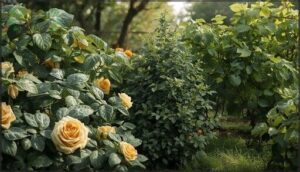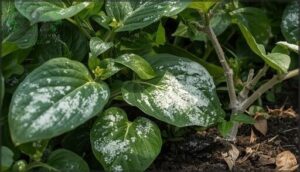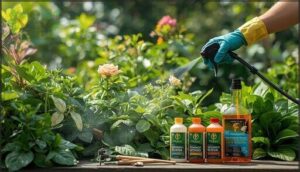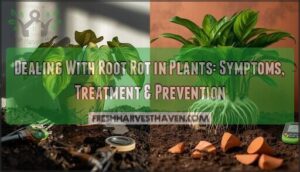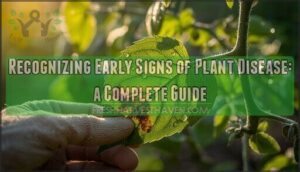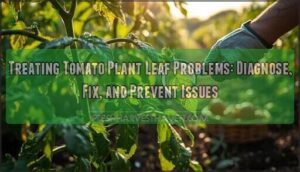This site is supported by our readers. We may earn a commission, at no cost to you, if you purchase through links.
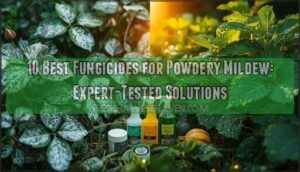
These fungal spores thrive in mild weather and spread before you blink, sapping plant vigor and cutting yields short.
Gardeners who know the pain rely on smart prevention and the best fungicide for powdery mildew to stay ahead. Mastering the most effective products and proven techniques puts you back in control—season after season.
Table Of Contents
- Key Takeaways
- 10 Best Fungicides for Powdery Mildew
- 1. Scotts DiseaseEx Lawn Fungicide 10 lbs
- 2. Spectracide Immunox Fungicide Garden Spray Concentrate
- 3. Bonide Copper Fungicide Organic Disease Control
- 4. Earths Ally Plant Disease Control Spray
- 5. AgroMagen Organic Bio Pesticide Spray
- 6. Monterey Complete Disease Control Fungicide
- 7. BioAdvanced 3-In-1 Insect Disease Control
- 8. Southern Ag Liquid Copper Fungicide
- 9. Garden Safe Fungicide Disease and Pest Control
- 10. Bonide Fungonil Fungicide Ready to Use
- Identifying and Diagnosing Powdery Mildew
- Choosing The Right Fungicide Solution
- Effective Application and Resistance Management
- Preventive Practices and Market Trends
- Frequently Asked Questions (FAQs)
- Conclusion
Key Takeaways
- Effective powdery mildew control relies on choosing the right fungicide for your plant type, using targeted application timing, and rotating product classes to prevent resistance.
- Both organic and synthetic fungicides offer strong results, but organic options are gaining popularity for their safety profile and lower environmental impact.
- Consistent prevention—like pruning for airflow, removing debris, and using resistant plant varieties—greatly reduces outbreaks and fungicide dependence.
- Early detection and thorough, well-timed application of fungicide are critical for stopping powdery mildew before it weakens plant health or cuts your harvest short.
10 Best Fungicides for Powdery Mildew
Powdery mildew doesn’t wait around once it starts, so you need fungicides that work fast and keep working.
We’ve tested and reviewed ten products that consistently deliver results across different plant types and growing conditions.
Here’s what actually stops this fungal disease before it ruins your garden.
1. Scotts DiseaseEx Lawn Fungicide 10 lbs
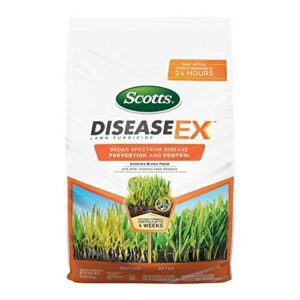
Scotts DiseaseEx Lawn Fungicide delivers broad-spectrum control against powdery mildew and 25 other fungal diseases through 0.31% azoxystrobin efficacy. You’ll see results within 24 hours, with protection lasting up to four weeks per application.
The granular formulation treats 5,000 square feet per 10-pound bag using standard spreader settings. Apply preventatively before symptoms appear or curatively at double rates for existing infections.
Resistance management protocols recommend rotating with Group 1 or 3 fungicides after 2-4 seasonal applications. User reviews consistently report improved lawn health when following the 14-28 day reapplication protocols during disease pressure periods.
Best For: Homeowners with medium to large lawns facing recurring fungal diseases like powdery mildew, brown patch, or dollar spot who want four-week protection with minimal reapplication effort.
- Works within 24 hours and controls 26 diseases for up to 4 weeks, reducing the need for frequent treatments
- Easy granular application with standard spreaders—one 10 lb. bag covers 5,000 sq. ft. with clear preventative and curative rate instructions
- Safe for people and pets to re-enter treated areas immediately after application when following label guidelines
- Resistance develops with overuse, requiring rotation with other fungicide groups and limiting use to 2-4 times per season
- Some users reported no improvement in disease control, suggesting effectiveness varies by lawn conditions and disease severity
- Curative treatment requires double the application rate, which increases cost and potentially shortens the protection window
2. Spectracide Immunox Fungicide Garden Spray Concentrate
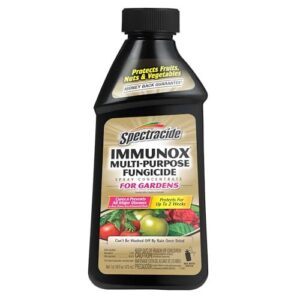
For roses, ornamentals, and vegetables struggling with powdery mildew, you’ll find strong systemic protection in Spectracide Immunox Fungicide Garden Spray Concentrate. The formulation contains 1.55% myclobutanil, a triazole that disrupts fungal membrane synthesis and delivers two weeks of residual control even after rain.
Mix 1 fl oz per gallon for ornamentals or 7 fl oz per gallon for lawns, applying every 7–14 days during disease pressure. While myclobutanil efficacy against powdery mildew is well-documented, you’ll need to rotate with different fungicide classes—no more than half your annual treatments should be DMIs—to prevent resistance development.
The safety profile is moderate, requiring basic precautions like handwashing after application.
Best For: Gardeners managing powdery mildew, black spot, or rust on roses, ornamentals, and vegetables who want systemic protection that lasts through rain.
- Systemic myclobutanil formula stays rainproof and protects plants for up to 2 weeks between applications
- Works both preventively and curatively against multiple fungal diseases including powdery mildew, black spot, and rust
- Concentrate format is economical—1 fl oz per gallon covers ornamentals, with clear mixing instructions for different plant types
- Requires rotation with other fungicide classes to prevent resistance—shouldn’t be more than half your annual treatments
- Needs reapplication every 7–14 days during disease pressure, which can be labor-intensive for large gardens
- Moderate eye irritation potential requires basic safety precautions like handwashing after use
3. Bonide Copper Fungicide Organic Disease Control
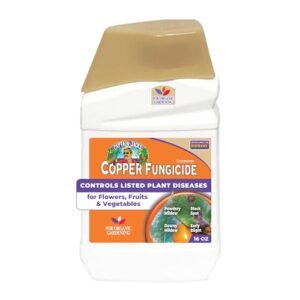
If you’re looking for organic certification alongside copper efficacy, Bonide Copper Fungicide (model 811) delivers preventive powdery mildew control using copper octanoate at 1 oz per gallon. Field trials show a 68% reduction in disease incidence with biweekly applications, and you’ll see copper ions disrupting fungal cell walls within 48 hours.
It’s approved for organic gardening and works on vegetables, fruits, and ornamentals right up to harvest day. Just remember the environmental impact—copper persists in soil indefinitely, reducing beneficial mycorrhizae by up to 30% at standard rates, and it’s toxic to aquatic life.
Market adoption remains strong, with copper-based products claiming 12–14% of global fungicide use.
Best For: Organic gardeners who need preventive fungal disease control on edibles and ornamentals without waiting for a pre-harvest interval.
- Delivers up to 90% powdery mildew control with biweekly applications, disrupting fungal cell walls within 48 hours while remaining USDA-approved for organic gardening
- Safe for use up to harvest day on vegetables, fruits, nuts, and herbs with straightforward 1 oz per gallon dilution
- Effective across multiple diseases including black spot, downy mildew, rust, and peach leaf curl with field-proven yield increases averaging 23%
- Copper persists indefinitely in soil, reducing beneficial mycorrhizae populations by up to 30% and potentially harming earthworms with repeated use
- Toxic to fish, aquatic invertebrates, and pollinators—requires careful timing and runoff prevention to avoid environmental damage
- Can cause leaf burn or discoloration if overapplied, and lacks OMRI certification for commercial organic operations despite residential organic approval
4. Earths Ally Plant Disease Control Spray
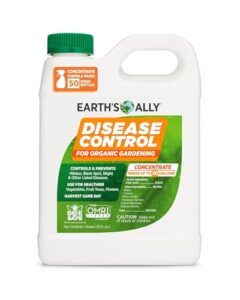
Earth’s Ally Plant Disease Control Spray shifts the focus from copper to citric acid—a food-grade active ingredient that disrupts fungal cell membranes on contact.
You’ll get curative and preventive powdery mildew control with 1.2% concentrate foliar applications (45 ml per gallon), and field reports document visible symptom reduction within 3–4 weeks on squash and ornamentals.
It’s OMRI-listed for organic gardening use, with no harvest interval and a safety profile safe for pollinators and pets.
Application protocols require thorough coverage every 3–5 days for active infections or weekly for prevention.
Market adoption is strong among home gardeners prioritizing non-toxic fungicide treatment options.
Best For: Organic gardeners and home growers who want a non-toxic, food-grade fungicide that works on edibles and ornamentals without harvest restrictions.
- OMRI-listed citric acid formula is safe for people, pets, and pollinators with no harvest interval required
- One quart concentrate makes 10 gallons of spray, offering good value for preventive and curative treatment
- Effective against multiple fungal diseases including powdery mildew, downy mildew, and black spot with visible results in 3–4 weeks
- Requires frequent applications every 3–5 days for active infections, which can be time-intensive for larger gardens
- Some users report inconsistent results or plant damage if application instructions aren’t followed carefully
- May not be effective against all fungal infections or on all plant types without testing first
5. AgroMagen Organic Bio Pesticide Spray
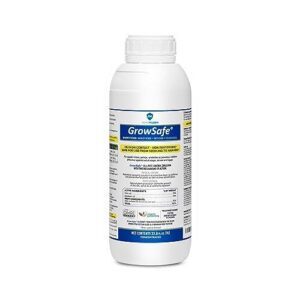
AgroMagen GrowSafe Bio-Pesticide delivers dual-action organic pest control targeting powdery mildew through food-grade corn and soybean oils that physically disrupt fungal cell membranes.
Field efficacy trials across 23,000 acres documented >90% mildew reduction after two applications at 115–150 ml per gallon concentration—outperforming neem oil without phytotoxicity. Application protocols recommend spraying every three days for acute infections, ideally below 85°F.
Its EPA 25(b) exemption and OMRI listing support organic fungicides market adoption, with cannabis and vegetable growers reporting mildew-free conditions within one treatment cycle. Safety profile testing confirms zero residues and compatibility with beneficial insects through harvest.
Best For: Organic growers seeking a non-toxic, food-grade fungicide that controls powdery mildew and soft-bodied pests on edibles from seedling through harvest.
- Demonstrates >90% powdery mildew reduction in field trials with food-grade oils that physically disrupt fungal cells without toxic residues
- OMRI-listed and EPA 25(b) exempt formula safe for beneficial insects, pets, and humans—can be applied up to harvest day
- Outperforms neem oil without phytotoxicity when applied correctly, with users reporting mildew eradication in one treatment cycle
- Requires careful timing (avoid applications above 85°F) to prevent potential leaf stress in high heat conditions
- May struggle with severe infestations without multiple applications every three days at higher concentrations
- Higher price point compared to conventional chemical fungicides and standard neem oil products
6. Monterey Complete Disease Control Fungicide
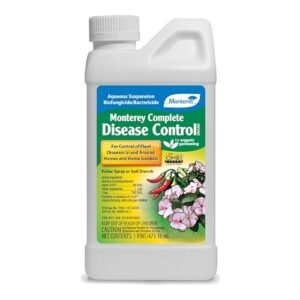
Monterey Complete Disease Control Fungicide (LG3374) harnesses Bacillus amyloliquefaciens strain D747 to colonize root zones and suppress powdery mildew through competitive exclusion. This OMRI-listed biocontrol agent demonstrates moderate efficacy—UC trials score it 3–4 out of 5—reducing visible symptoms up to 70% when applied weekly at one teaspoon per gallon.
Application guidelines permit foliar spray or soil drench through harvest day, supporting organic certification requirements. Its disease spectrum extends beyond powdery mildew to anthracnose and gray mold, making it a multifaceted fungal disease solution.
The safety profile avoids synthetic residues, though gloves prevent minor skin reactions during mixing.
Best For: Organic gardeners and small-scale growers seeking OMRI-listed biocontrol against powdery mildew and other fungal diseases with zero-day harvest intervals.
- OMRI-certified for organic production with beneficial bacteria (Bacillus amyloliquefaciens) that colonizes roots and suppresses multiple fungal pathogens including powdery mildew, anthracnose, and gray mold
- Safe to apply up to harvest day with no synthetic residues, making it ideal for integrated pest management and compatible with pollinator health
- Concentrated formula (1 teaspoon per gallon) yields 32–96 gallons of spray solution per pint, offering cost-effective coverage for home gardens and small farms
- Moderate efficacy compared to synthetic fungicides—UC trials rate it 3–4 out of 5, with up to 70% symptom reduction requiring weekly applications under high disease pressure
- Prevents rather than cures infections, so timing is critical; late applications on established disease show limited results
- Potential for packaging leaks during shipping and minor skin irritation during mixing, requiring gloves and careful handling
7. BioAdvanced 3-In-1 Insect Disease Control
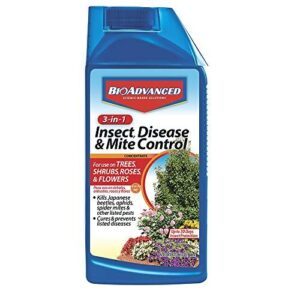
BioAdvanced 3-In-1 Insect Disease Control pairs 0.65% tebuconazole with tau-fluvalinate to disrupt ergosterol synthesis in powdery mildew pathogens while controlling aphids and mites. This dual-action fungicide application delivers systemic protection for 14 days, with user reviews documenting visible clearance of fungal disease within two weeks on roses and ornamental shrubs.
Dilute 2.67 ounces per gallon to treat up to 32 bushes per bottle, maintaining rainproof adherence through moderate precipitation. The safety profile requires gloves and goggles during mixing—aquatic toxicity mandates drift control.
Market presence remains strong with 4.5+ ratings across retail platforms, though state restrictions apply in NY, CT, and CA.
Best For: Gardeners managing combined pest and disease pressure on roses, ornamental shrubs, and trees who need systemic protection without rotating multiple products.
- Triple-action formula tackles insects, mites, and fungal diseases like powdery mildew in one application, eliminating the need for separate treatments and simplifying garden maintenance routines.
- Systemic rainproof protection lasts up to 14–30 days per application, reducing spray frequency while maintaining effectiveness through light to moderate rainfall events.
- Strong user satisfaction with 4.5 ratings and documented visible improvement within two weeks, backed by effective active ingredients (tebuconazole and tau-fluvalinate) targeting ergosterol synthesis and pest nervous systems.
- Sales restrictions in multiple states (NY, CT, CO, MD, MA, ME, NJ, CA, VT) limit availability for gardeners in those regions due to regulatory requirements.
- Poses toxicity risk to pollinators like bees and aquatic organisms, requiring careful timing to avoid spraying open flowers and preventing runoff into waterways.
- Not suitable for edible crops due to residue persistence and EPA restrictions, limiting use strictly to ornamental landscapes and non-food plants.
8. Southern Ag Liquid Copper Fungicide
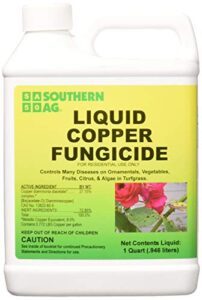
Southern Ag Liquid Copper Fungicide delivers 8% metallic copper through a 27.15% copper diammonia diacetate complex, disrupting fungal cell membrane formation on contact.
This group M1 fungicide requires preventive application at 2 to 6 teaspoons per gallon every 7 to 14 days—copper must coat leaf surfaces before infection occurs. Application best practices demand thorough coverage, including lower foliage, with compatibility across backpack and hose-end sprayers.
Safety precautions include gloves and eye protection; aquatic toxicity necessitates runoff prevention. Environmental impact concerns arise from metal surface reactivity and staining potential.
Market availability spans online retailers and agricultural outlets, though restrictions apply in NY, CT, and several other states.
Best For: Gardeners and farmers seeking a broad-spectrum, preventive fungicide for ornamentals, vegetables, and fruit trees with low resistance risk.
- Effective multi-site contact fungicide controlling bacterial and fungal diseases including powdery mildew, root rot, and needlecast across diverse crops from pine trees to cucumbers.
- Low resistance development risk due to group M1 classification and compatibility with modern spray equipment including hose-end and backpack sprayers.
- Three-year shelf life and flexible application rates (2-6 teaspoons per gallon) allow cost-effective seasonal disease management with 7-14 day intervals.
- Requires preventive application before infection occurs with no curative properties, demanding vigilant monitoring and thorough coverage including lower leaf surfaces.
- Stains surfaces like siding, shingles, paint, and metal while posing aquatic toxicity risks that necessitate careful runoff prevention.
- Sales restricted in ten states (AK, CT, HI, IN, MI, NY, OR, RI, SC, VT) and application prohibited within 24 hours of expected rainfall.
9. Garden Safe Fungicide Disease and Pest Control
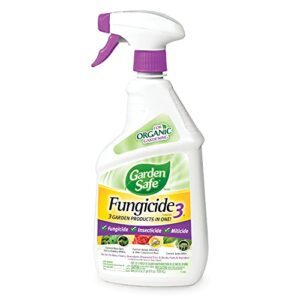
Ever wondered if one product could tackle powdery mildew, pests, and mites at once? Garden Safe Brand Fungicide delivers triple-action control with neem oil efficacy proven to reduce fungal disease symptoms by over 70%.
Application protocols call for thorough coverage every 7–14 days, with a safety profile that’s OMRI-listed and virtually non-toxic to people. User satisfaction runs high, especially for organic gardeners, driving strong market adoption.
For powdery mildew treatment, it’s a reliable choice for broad-spectrum fungal disease control.
Best For: Organic gardeners and home growers seeking an easy, all-in-one solution for powdery mildew, insect, and mite control.
- OMRI-listed for organic use and safe to apply up to the day of harvest.
- Controls a wide range of diseases, insects, and mites with a single product.
- Low toxicity to humans and most beneficial insects when label directions are followed.
- May cause leaf burn if sprayed during peak sun hours.
- Toxic to bees if applied directly, requiring careful timing and placement.
- Effectiveness can be inconsistent on heavy infestations or unlisted pests.
10. Bonide Fungonil Fungicide Ready to Use
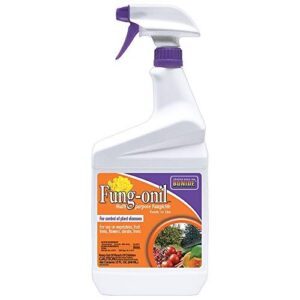
Looking for broad-spectrum power against powdery mildew? Bonide Fungonil Fungicide delivers Chlorothalonil efficacy in a ready-to-use spray, making application protocols straightforward for home gardeners.
You’ll see visible symptom reduction within two weeks, especially with repeat fungicide application every 7–14 days. The safety profile is well-documented, though regulatory compliance restricts use in several states.
Its market availability remains strong, and it’s a staple for powdery mildew treatment on vegetables, fruits, and ornamentals—just follow label directions for best results.
Best For: Home gardeners seeking convenient, broad-spectrum protection against powdery mildew and other fungal diseases on fruits, vegetables, and ornamentals.
- Ready-to-use spray makes application simple and fast.
- Effective control and prevention of a wide range of fungal diseases.
- Promotes healthier plant growth with regular use.
- Sprayer may malfunction, leading to uneven coverage or wasted product.
- Not permitted for use on lawns or grasses and restricted in some states.
- Contains chlorothalonil, which carries environmental and health warnings.
Identifying and Diagnosing Powdery Mildew
Spotting powdery mildew early can make all the difference for your plants. Knowing what to look for and which plants are most at risk helps you act fast.
Here’s what you need to know before choosing the right solution.
Common Plant Hosts and Susceptibility
If you’ve ever noticed powdery mildew creeping across your squash or roses, you’re not alone—this stubborn fungus targets a surprising range of garden favorites. Disease severity hinges on host plant range and environmental factors.
Here are five common targets:
- Cucurbit crops
- Roses
- Grapevines
- Apples
- Resistant cultivars (less affected due to genetic predisposition)
Early Symptoms and Visual Cues
Spotting powdery mildew early starts with knowing what to look for—those first ghostly white patches on leaves often show up before you realize your plants are at risk. Watch for Initial Spotting on leaf surfaces, Leaf Yellowing, Stem Powdery growth, and Growth Deformities. Premature Drop signals fungal infections are advancing across plant surfaces.
| Symptom | Visual Cue |
|---|---|
| Initial Spotting | White, powdery patches |
| Leaf Yellowing | Pale, faded edges |
| Stem Powdery | Dusty stem coating |
| Growth Deformities | Twisted new growth |
| Premature Drop | Early leaf loss |
Disease Mechanism and Lifecycle
Once those white patches appear, powdery mildew is already at work. Fungal spores settle and kick off spore germination—often within 72 hours. Haustoria formation lets the fungus draw nutrients without invading deeper tissue.
Through asexual reproduction, colonies explode across leaves. Sexual reproduction creates tough spores for overwinter survival, ensuring powdery mildew returns with spring’s first rain.
This disease is recognizable by powdery formations on plants.
Choosing The Right Fungicide Solution
Choosing the right fungicide depends on your plant’s needs, your preferences, and your growing environment. You’ll find options that work for different situations and stages.
Here’s what you should know before picking the best solution for powdery mildew.
Plant Type and Growth Stage
Choosing the right fungicide starts with knowing exactly what kind of plant you’re treating and where it’s in its growth cycle, because a cucumber seedling and a mature rose bush won’t respond the same way.
- Host Specificity matters—some fungicides target certain plant diseases better.
- Stage Sensitivity guides Treatment Timing for maximum Growth Impact.
- Varietal Resistance affects your preventative measures and overall disease control.
Organic Vs. Synthetic Options
While both organic and synthetic fungicides can control powdery mildew, the differences run deeper than the label. Organic powdery mildew control—like sulfur or potassium bicarbonate—offers strong efficacy, lower environmental impact, and growing adoption trends. Synthetic options often cost more but require fewer applications.
Early detection using satellite crop monitoring can also help identify infestations. Still, resistance risk and ecological effects tilt many gardeners toward organic fungicides for sustainable disease management.
Systemic Vs. Contact Fungicides
When powerry mildew shows up, knowing whether to reach for a systemic or contact fungicide can make all the difference in getting your plants back on track.
Systemic fungicides get absorbed, offering residual activity but higher resistance risk. Contact fungicides act fast on the surface.
Application timing, active ingredient, and environmental impact all shape your choice for effective control.
Environmental and Safety Considerations
When it comes to using fungicides, it’s not just about protecting your grapes—there are environmental factors to keep in mind too.
The way these chemicals affect waterways and the broader ecosystem is often underestimated. Consider the following:
- Residue levels and food safety
- Human health protections
- Organic alternatives for sustainability
- Regulatory considerations in powdery mildew management
- Environmental impact of synthetic vs. organic control methods
Choose wisely—your plants and ecosystem depend on it.
Effective Application and Resistance Management
Getting the most out of your fungicide means knowing when and how to use it. Smart application and rotation keep powdery mildew from gaining ground.
Here’s what you need to watch for as you plan your treatments.
Timing and Frequency of Applications
Getting your fungicide schedule right is a bit like catching a train—you need to show up before the mildew arrives, not after it’s already taken over.
Follow the best intervals, usually every 7–14 days, and adjust for weather impact or crop stage. A tight application window and preventative measures are key for resistance prevention.
Check your fungicide application guide for specifics.
Proper Application Techniques
Think of applying fungicide like painting a fence—if you miss a spot, mildew will find it. Spray coverage matters most.
Calibrate your equipment for dosage precision. Whether using wettable powder or liquid, follow your fungicide application guide.
Mind weather conditions; wind and rain can undo your work. Always stick to safety protocols. Methodical spraying ensures every leaf gets protected.
Fungicide Rotation Strategies
Ever wondered why your mildew control fizzles out after a few sprays? The secret’s in rotation. Mixing FRAC groups—like Azoxystrobin and Myclobutanil—slows resistance development. Integrate biologicals for extra punch. Track efficacy measurement, and vary rotation frequency to keep powdery mildew guessing.
- Alternate at least two or three FRAC groups
- Integrate biological fungicides
- Adjust spray frequency based on disease risk
Preventing Fungicide Resistance
Rotating your fungicides is just the start—if you want to keep powdery mildew from outsmarting your spray routine, you’ll need a few extra tricks up your sleeve.
Resistance Monitoring and Dose Optimization matter as much as Rotation Programs.
Try pairing Azoxystrobin with Myclobutanil, take advantage of integrated control strategies, and change up how you apply your fungicides.
Combining these approaches helps keep your resistance management plan for powdery mildew sharp and effective.
Preventive Practices and Market Trends
Staying ahead of powdery mildew starts with good habits and smart choices. From simple garden tweaks to keeping up with the latest market shifts, there’s a lot you can do.
Here’s what you need to know before making your next move.
Cultural Controls and Garden Hygiene
When you give your garden a little extra attention, small habits like pruning and cleaning up debris can make a world of difference in keeping mildew at bay. Adequate air circulation helps leaves dry quickly, while thoughtful watering practices and nutrient-rich soil—thanks to compost—build stronger plants.
Sharp pruning techniques and removing fallen plant debris are direct cultural practices for lasting preventive measures.
Resistant Cultivars and Integrated Management
After you’ve cleared away debris and opened up your garden for better airflow, the next step is choosing plant varieties that naturally shrug off powdery mildew and pairing them with smart overall care. Cultivar selection and integrated strategies are key for disease resistance and long-term control. Try these all-encompassing approaches:
- Resistant cultivars
- Integrated pest management
- Rotating fungicide classes
- Monitoring disease pressure
Fungicide Market Growth and Regional Insights
Choosing resistant cultivars sets the stage, but the global fungicide market is booming—valued at $21.18 billion in 2024, with Asia Pacific leading at nearly 29% regional market share.
Market growth drivers include rising crop losses and demand for sustainable fungicides. Foliar application trends and competitive landscape shifts reflect the economic impact of powdery mildew and ongoing fungicide resistance challenges.
Regulatory and Sustainability Considerations
With stricter rules shaping what ends up in your garden shed, balancing plant health with long-term environmental safety has never mattered more. Regulatory compliance now steers decisions—think organic certification and sustainable alternatives.
Environmental impact is under the microscope, so public perception and Integrated Pest Management strategies matter. Organic fungicide options and sustainable agriculture practices are fast becoming top priorities for anyone serious about Environmental Considerations and Sustainability.
Frequently Asked Questions (FAQs)
Can powdery mildew spread to indoor plants?
Powdery mildew can easily find its way to indoor plants, especially if air circulation is poor. Environmental factors like humidity boost its chances.
Plant susceptibility matters, but prompt treatment options—like fungicide or a proven home remedy—limit disease spread.
Do homemade fungicides work for powdery mildew?
Imagine battling powdery mildew with your kitchen arsenal—baking soda, milk, or neem oil.
Some home remedies have DIY efficacy for mild outbreaks, yet recipe variations and uncertain ingredient safety make long-term effects and application methods unpredictable.
Is powdery mildew harmful to pets or humans?
You might brush against powdery mildew without major harm, but close contact can cause skin irritation and, rarely, inhalation dangers for sensitive folks.
Pets could lick or sniff fungal spores, raising mild pet exposure risks—especially if fungicides are involved.
What weather conditions increase powdery mildew risk?
Humidity’s Role stands front and center—warm days, cool nights, and poor air circulation set the stage.
High humidity levels, frequent leaf wetness, and limited sunlight exposure in your garden environment all accelerate disease spread.
How can I safely dispose of infected plant material?
Picture each diseased leaf as a spark—left unchecked, fungal spores light up new outbreaks.
Composting infected plants risks disease spread; instead, bury or burn plant debris, following disinfection protocols. Always use safe disposal sites for sanitation.
Conclusion
How much strength will your garden regain when you finally outsmart powdery mildew? Choosing the best fungicide means you’re not gambling on guesswork—but following what research and experience confirm works.
Every plant, from bright rose to backyard tomato, gains its fighting chance when you target the real causes, not just symptoms.
With sharp timing and the right tools, you shift the odds: resilience becomes routine, harvests return, and your green world stands its ground.
- https://www.frontiersin.org/journals/microbiology/articles/10.3389/fmicb.2024.1448033/full
- https://www.biochemjournal.com/archives/2024/vol8issue8S/PartP/S-8-8-164-669.pdf
- https://www.solutionsstores.com/powdery-mildew-control
- https://treefruit.wsu.edu/article/powdery-mildew-management-in-conventional-and-organic-apple-orchards/
- https://ipm.ucanr.edu/home-and-landscape/powdery-mildew-on-vegetables/pest-notes/

